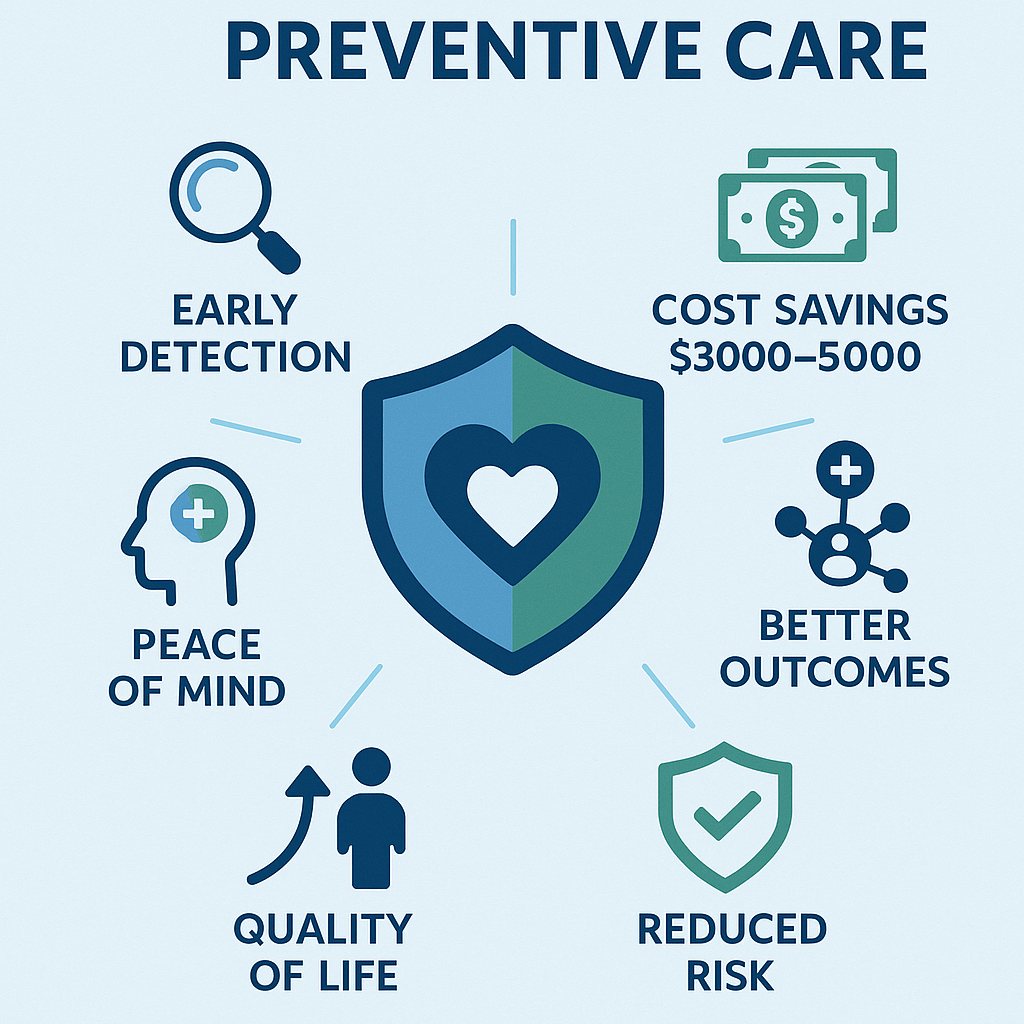Key Points
- Home-based wellness solutions can reduce fitness costs by up to 80% while providing the same health benefits as expensive gym memberships and personal training sessions.
- Preventive healthcare strategies like regular check-ups and healthy lifestyle choices can save families an average of $3,000-$5,000 annually in medical expenses while improving long-term health outcomes.
- Smart nutrition planning through bulk buying, seasonal eating, and meal preparation can cut food costs by 40% while significantly improving dietary quality and nutritional intake.
In today's economy, maintaining good health while managing expenses has become a critical concern for millions of Americans. With healthcare costs continuing to rise and wellness programs often carrying premium price tags, many people believe that achieving optimal health requires significant financial investment. However, recent research and expert analysis reveal that the most effective health improvements often come from simple, cost-effective strategies that anyone can implement regardless of their budget.
The relationship between financial wellness and physical health is more interconnected than many realize. According to the Harvard School of Public Health, financial stress directly impacts physical health outcomes, creating a cycle where poor health leads to higher medical expenses, which in turn creates more financial stress [1]. Breaking this cycle requires strategic approaches that simultaneously improve health while reducing long-term healthcare costs.

Understanding the True Cost of Health
Before exploring money-saving strategies, it's essential to understand where healthcare dollars typically go. The Centers for Disease Control and Prevention reports that chronic diseases account for over 86% of healthcare costs in the United States, with much of this being preventable through lifestyle modifications [2]. This statistic reveals a crucial opportunity: by investing in prevention through affordable lifestyle changes, individuals can avoid the substantial costs associated with treating chronic conditions later in life.
The concept of "health investment" versus "health expense" represents a fundamental shift in thinking. While a gym membership might seem like an expense, the long-term savings from reduced medical bills, improved productivity, and enhanced quality of life often far exceed the initial investment. However, even these investments can be optimized for maximum benefit at minimum cost.
1. Create a Comprehensive Home Fitness Environment
The fitness industry has undergone a dramatic transformation, particularly following the global pandemic. Home fitness solutions have evolved from basic workout videos to sophisticated, technology-enhanced experiences that rival traditional gym offerings. Creating an effective home gym doesn't require expensive equipment or large spaces – it requires strategic planning and smart investments.
Equipment Essentials for Maximum Impact
Research published in the Journal of Sports Medicine and Physical Fitness demonstrates that bodyweight exercises and minimal equipment workouts can provide the same cardiovascular and strength benefits as complex gym machinery [3]. A basic home gym setup might include:
- Resistance bands ($15-30): Provide variable resistance equivalent to a full weight room
- Yoga mat ($20-40): Essential for floor exercises, stretching, and mindfulness practices
- Adjustable dumbbells ($50-150): Replace an entire rack of weights in minimal space
- Stability ball ($15-25): Enhances core training and provides seating alternative
Digital Fitness Solutions
The proliferation of high-quality fitness apps and online platforms has democratized access to professional-grade instruction. Apps like FitOn, Nike Training Club, and YouTube Fitness offer thousands of workouts across all fitness levels, often at no cost. These platforms provide:
- Structured workout programs designed by certified trainers
- Progress tracking and goal-setting features
- Community support and motivation
- Flexibility to exercise on your schedule
Outdoor Exercise Opportunities
Nature provides the ultimate free gym, offering both physical and mental health benefits that indoor environments cannot replicate. Studies from Stanford University show that outdoor exercise provides 50% greater stress reduction compared to indoor activities [4]. Free outdoor activities include:
- Walking and hiking on local trails
- Bodyweight exercises in parks
- Swimming in public pools or natural bodies of water
- Cycling on bike paths and quiet roads
- Outdoor yoga and meditation
2. Master the Art of Preventive Healthcare

Preventive healthcare represents one of the most powerful tools for reducing long-term medical expenses while maintaining optimal health. The concept extends beyond annual check-ups to encompass a comprehensive approach to health maintenance that identifies and addresses potential issues before they become serious medical problems.
Strategic Health Screenings
Many insurance plans cover preventive screenings at 100%, making them essentially free to the patient. Taking advantage of these benefits can catch health issues early when they're most treatable and least expensive to address. Essential screenings include:
- Annual physical examinations
- Blood pressure and cholesterol monitoring
- Cancer screenings appropriate for age and risk factors
- Dental cleanings and oral health assessments
- Vision and hearing evaluations
Building Relationships with Healthcare Providers
Establishing ongoing relationships with primary care providers creates opportunities for more personalized, cost-effective care. Providers who know your health history can make more accurate diagnoses, prescribe more targeted treatments, and help you avoid unnecessary procedures or specialist referrals.
Understanding Insurance Benefits
Many people underutilize their health insurance benefits, missing opportunities for covered services that could improve their health and prevent future problems. Key areas to explore include:
- Wellness programs and health coaching
- Nutrition counseling and weight management programs
- Mental health services and stress management resources
- Prescription drug coverage and generic alternatives
3. Implement Smart Nutrition Strategies
Nutrition represents one of the most impactful areas for both health improvement and cost savings. The common misconception that healthy eating is expensive often stems from focusing on premium organic products and specialty health foods rather than fundamental nutritional principles.
Bulk Buying and Meal Planning
Strategic purchasing can dramatically reduce food costs while improving nutritional quality. Buying non-perishable healthy staples in bulk – such as whole grains, legumes, nuts, and seeds – can reduce per-serving costs by 30-50%. These foods form the foundation of a healthy diet and have extended shelf lives, making them ideal for budget-conscious shoppers.
Seasonal and Local Eating
Aligning food choices with seasonal availability provides both nutritional and financial benefits. Seasonal produce is typically:
- 40-60% less expensive than out-of-season alternatives
- Higher in nutritional content due to shorter transport times
- More environmentally sustainable
- Available in greater variety at farmers markets and local stores
Home Cooking and Food Preparation
Developing basic cooking skills represents one of the highest-return investments in both health and finances. Home-prepared meals typically cost 60-70% less than restaurant equivalents while providing better nutritional control. Key strategies include:
- Batch cooking and meal preparation on weekends
- Learning versatile cooking techniques that work with various ingredients
- Investing in basic kitchen tools that improve efficiency
- Understanding food storage methods to minimize waste
4. Optimize Water Consumption and Quality
Proper hydration plays a crucial role in virtually every bodily function, yet many people either don't drink enough water or spend unnecessarily on bottled water. The average American spends over $300 annually on bottled water, despite having access to safe, regulated tap water in most areas.
Water Filtration Solutions
Installing a quality water filtration system provides several benefits:
- Eliminates the ongoing cost of bottled water
- Removes chlorine, sediment, and other taste-affecting compounds
- Provides peace of mind about water quality
- Reduces plastic waste and environmental impact
Filter options range from simple pitcher filters ($20-40) to under-sink systems ($100-300), with most paying for themselves within 6-12 months compared to bottled water costs.
Hydration Strategies for Health
Proper hydration supports:
- Optimal kidney function and toxin elimination
- Healthy skin and reduced signs of aging
- Improved cognitive function and mental clarity
- Better appetite regulation and weight management
- Enhanced physical performance and recovery
5. Embrace Natural and DIY Health Solutions
Many effective health and wellness solutions can be created at home using simple, natural ingredients. This approach not only saves money but often provides gentler, more sustainable alternatives to commercial products.
Natural Cleaning Products
Commercial cleaning products often contain harsh chemicals that can irritate respiratory systems and skin. Simple alternatives include:
- White vinegar: Natural disinfectant and deodorizer
- Baking soda: Gentle abrasive and stain remover
- Lemon juice: Natural bleaching agent and fresh scent
- Essential oils: Antimicrobial properties and pleasant fragrances
DIY Personal Care Products
Many personal care items can be made at home with simple ingredients:
- Sugar scrubs for exfoliation using sugar and coconut oil
- Face masks using oatmeal, honey, and yogurt
- Hair treatments using natural oils and ingredients
- Deodorants using baking soda and essential oils
6. Leverage Community Resources and Programs
Communities across the country offer numerous free or low-cost health and wellness resources that many residents don't know about or underutilize. These programs are often funded by local governments, non-profit organizations, or healthcare systems as part of community health initiatives.
Public Recreation Facilities
Most communities provide access to:
- Public pools with lap swimming and water aerobics
- Tennis and basketball courts
- Walking and biking trails
- Playgrounds and outdoor fitness equipment
- Community centers with group fitness classes
Library and Community Center Programs
Public libraries have evolved far beyond book lending to become comprehensive community wellness hubs. Many offer:
- Free fitness classes and wellness workshops
- Health screening events
- Nutrition education programs
- Stress management and meditation classes
- Access to health and fitness databases and resources
Healthcare System Community Programs
Local hospitals and healthcare systems often provide free community education programs covering topics such as:
- Chronic disease management
- Nutrition and cooking classes
- First aid and CPR training
- Mental health awareness and support
- Preventive care education
7. Maximize Insurance Benefits and Healthcare Savings
Understanding and optimizing health insurance benefits can result in significant savings while improving access to care. Many people pay for services that their insurance would cover or miss opportunities for additional benefits included in their plans.
Health Savings Accounts (HSAs) and Flexible Spending Accounts (FSAs)
These tax-advantaged accounts allow you to pay for qualified medical expenses with pre-tax dollars, effectively providing a discount equal to your tax rate. Qualified expenses often include:
- Prescription medications and over-the-counter drugs
- Medical equipment and supplies
- Preventive care and screenings
- Mental health services
- Alternative therapies like acupuncture and chiropractic care
Generic Medications and Prescription Assistance
Generic medications provide the same therapeutic benefits as brand-name drugs at typically 80-90% lower costs. Additionally, many pharmaceutical companies offer patient assistance programs for people who qualify based on income or insurance status.
Telemedicine and Virtual Care
Virtual healthcare consultations often cost significantly less than in-person visits while providing convenient access to medical professionals. Many insurance plans now cover telemedicine services, making them an affordable option for:
- Routine follow-up appointments
- Minor illness consultations
- Mental health counseling
- Prescription refills and medication management
8. Prioritize Mental Health and Stress Management
Mental health significantly impacts physical health and healthcare costs. Chronic stress contributes to numerous health problems, including cardiovascular disease, digestive issues, and immune system dysfunction. Addressing mental health proactively can prevent these secondary health problems and their associated costs.
Free and Low-Cost Mental Health Resources
- Meditation apps like Headspace and Calm offer free versions with guided meditations
- Support groups for various life challenges and health conditions
- Community mental health centers providing sliding-scale fee services
- Online therapy platforms offering more affordable alternatives to traditional therapy
- Crisis hotlines providing immediate support during difficult times
Stress Reduction Techniques
Simple stress management techniques can be learned and practiced without cost:
- Deep breathing exercises and progressive muscle relaxation
- Mindfulness meditation and present-moment awareness
- Journaling and expressive writing
- Time in nature and outdoor activities
- Social connection and community involvement
9. Build Social Support Networks for Health
Social connections play a crucial role in both mental and physical health outcomes. People with strong social support networks have lower rates of depression, better immune function, and longer life expectancy. Building these connections doesn't require expensive activities or memberships.
Community Involvement Opportunities
- Volunteering for local organizations and causes
- Joining walking groups or recreational sports leagues
- Participating in community gardens and environmental projects
- Attending free community events and festivals
- Joining hobby groups and interest-based clubs
Family and Friend Networks
Strengthening existing relationships provides mutual support for health goals:
- Cooking and sharing healthy meals together
- Exercising with friends and family members
- Sharing resources and knowledge about health topics
- Providing emotional support during challenging times
- Creating accountability partnerships for health goals
10. Invest in Long-Term Health Education
Knowledge represents one of the most valuable investments in long-term health and cost savings. Understanding how your body works, what it needs to function optimally, and how to recognize early warning signs of health problems empowers you to make better decisions and avoid costly mistakes.
Reliable Health Information Sources
- Government health websites like CDC.gov and NIH.gov
- Professional medical organizations and their patient education materials
- Peer-reviewed health publications and research studies
- Certified health professionals and their educational content
- Reputable health news sources that cite scientific evidence
Developing Health Literacy
Health literacy involves understanding:
- How to read and interpret nutrition labels
- Basic anatomy and physiology
- Common health conditions and their risk factors
- How medications work and potential side effects
- When to seek professional medical care versus self-care
Creating Your Personal Health Investment Plan
Implementing these strategies requires a personalized approach that considers your specific circumstances, health goals, and financial situation. Start by assessing your current health status and identifying areas where small changes could provide significant benefits.
Priority Setting Framework
- Address immediate safety concerns and urgent health issues
- Focus on high-impact, low-cost interventions like improved sleep and stress management
- Build sustainable habits that can be maintained long-term
- Gradually expand your health investment as resources allow
- Monitor progress and adjust strategies based on results
Budget Allocation Guidelines
Financial experts recommend allocating 5-10% of income to health and wellness investments. This might include:
- Basic fitness equipment and healthy food upgrades
- Preventive healthcare and insurance premiums
- Mental health support and stress management resources
- Education and skill development related to health
- Emergency fund for unexpected health expenses
Measuring Success and Return on Investment
Tracking the effectiveness of your health investments helps ensure you're getting maximum value from your efforts and spending. Success metrics should include both quantitative measures (like reduced medical expenses and improved biomarkers) and qualitative improvements (like increased energy and better mood).
Health Metrics to Monitor
- Physical measurements: weight, blood pressure, resting heart rate
- Laboratory values: cholesterol, blood sugar, inflammatory markers
- Functional assessments: strength, flexibility, endurance
- Mental health indicators: stress levels, sleep quality, mood
- Financial tracking: healthcare expenses, insurance claims, medication costs
Long-Term Benefits
The compound benefits of consistent health investments become more apparent over time:
- Reduced risk of chronic diseases and their associated costs
- Improved productivity and earning potential
- Enhanced quality of life and life satisfaction
- Greater independence and reduced need for assistance as you age
- Positive impact on family members and community
Conclusion
Building a healthier lifestyle while saving money requires strategic thinking, but it's entirely achievable with the right approach. The key lies in understanding that the most effective health improvements often come from simple, sustainable changes rather than expensive programs or products. By focusing on prevention, leveraging community resources, and making informed decisions about health investments, you can significantly improve your well-being while reducing long-term healthcare costs.
The strategies outlined in this guide provide a comprehensive framework for achieving better health on any budget. Remember that small, consistent actions compound over time to create significant improvements in both health outcomes and financial well-being. Start with one or two strategies that resonate most with your current situation, and gradually expand your approach as these become established habits.
Your health is your most valuable asset, and investing in it wisely pays dividends for years to come. By taking control of your health journey and making informed, cost-effective choices, you're not just saving money – you're investing in a higher quality of life for yourself and your loved ones.
References:
[1] Harvard School of Public Health. "Making health care more affordable." https://hsph.harvard.edu/news/making-health-care-more-affordable/
[2] Centers for Disease Control and Prevention. "Chronic Disease Prevention 2024 Update: Essential to our Health and Future." https://medwinpublisher.org/index.php/ABCA/article/view/1241
[3] Journal of Sports Medicine and Physical Fitness. "Cost-effectiveness analyses and their role in improving healthcare strategies." https://journals.lww.com/co-obgyn/fulltext/2013/12000/cost_effectiveness_analyses_and_their_role_in.12.aspx
[4] Stanford University. "Budget-Friendly Mental Wellness: 9 Free Ways to Boost Your Mood." https://www.onepeakmedical.com/budget-friendly-mental-wellness/








